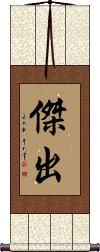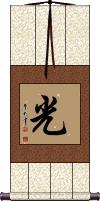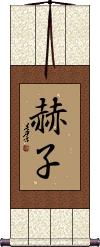Many custom options...
And formats...

Shining in Chinese / Japanese...
Buy a Shining calligraphy wall scroll here!
Personalize your custom “Shining” project by clicking the button next to your favorite “Shining” title below...
Excellence / Outstanding
Light / Bright / Shine
光 is the simplest way to express “light” in Chinese, Japanese Kanji, and old Korean Hanja.
It can also mean ray or bright. Chinese tend to use a two-character word for light/bright, so this character is probably best if your audience is Japanese. Also, when pronounced Rei, this can be a Japanese female given name.
In the Zen Buddhist context, this is the pure light that everyone possesses at their origin.
Kagune
A Traditional Warm Welcome
歡迎光臨 would be the ultimate Chinese “welcome mat.” Except it will be on your wall, and people will not step on it.
In a somewhat literal translation, you could say it means “I feel happy as I welcome you, as you have brought a shining light to this place with your arrival,” or more simply, “I am happy you've come as your presents brightens up the place.”
It has become common for this greeting to be announced by the staff upon the arrival of any customer into a fancy store in China. You will also see these characters on the “welcome mats” in front of 4 and 5-star hotels in China.
Having this on a wall scroll is an extra nice touch. I have seen a few horizontal scrolls with this phrase on the wall behind the reception desk of better hotels or near the front door of fine shops. At the fanciest department stores and restaurants in China, several greeters (almost always young women) will stand by the front door, all wearing sashes with this phrase embroidered. As you walk in, they will bow and say “huan ying guang lin” to welcome you to the establishment.
Note: The first two and last two characters do make words in Korean Hanja but are seldom used as a sentence like this in Korean.
This in-stock artwork might be what you are looking for, and ships right away...
Not the results for shining that you were looking for?
Below are some entries from our dictionary that may match your shining search...
| Characters If shown, 2nd row is Simp. Chinese |
Pronunciation Romanization |
Simple Dictionary Definition |
天 see styles |
tiān tian1 t`ien tien ten てん |
More info & calligraphy: Heaven(1) sky; (2) {Christn} heaven; (3) God; (4) {Buddh} svarga (heaven-like realm visited as a stage of death and rebirth); (5) {Buddh} deva (divine being of Buddhism); (6) top (of a book); (7) sole (of a Japanese sandal); (8) beginning; start; (9) (abbreviation) (See 天ぷら) tempura; (10) (abbreviation) (obsolete) (See 天竺・1) India; (given name) Hiroshi Heaven; the sky; a day; cf. dyo, dyaus also as 提婆 a deva, or divine being, deity; and as 素羅 sura, shining, bright. |
暐 𬀩 see styles |
wěi wei3 wei |
the bright shining of the sun |
曉 晓 see styles |
xiǎo xiao3 hsiao shou / sho しょう |
dawn; daybreak; to know; to let sb know; to make explicit (out-dated kanji) (out-dated or obsolete kana usage) dawn; daybreak; (out-dated kanji) (1) dawn; daybreak; (2) event (e.g. "in the event of ..."); occasion; occurrence; (female given name) Shou Dawn, shining, clear; to know, to make known. |
曜 see styles |
yào yao4 yao you / yo よう |
bright; glorious; one of the seven planets of premodern astronomy (female given name) Yō Brilliant, shining. 七曜 The sun, moon, and five planets. 曜宿 These seven and the constellations, the celestial orbs. |
杲 see styles |
gǎo gao3 kao hinode ひので |
high; sun shines brightly; to shine (surname) Hinode bright shining of the sun |
炅 see styles |
jiǒng jiong3 chiung |
(literary) bright; shining; brilliance |
炳 see styles |
bǐng bing3 ping hei / he へい |
bright; brilliant; luminous (adj-t,adv-to) (obsolete) bright; shining; clear; evident |
煥 焕 see styles |
huàn huan4 huan akira あきら |
(bound form) shining; glowing; lustrous (given name) Akira |
爍 烁 see styles |
shuò shuo4 shuo shaku |
bright; luminous Bright, glistening, flashing, shining; translit. c, ś. |
苪 see styles |
bǐng bing3 ping |
bright; shining, splendid |
銑 铣 see styles |
xiǎn xian3 hsien zuku ずく |
shining metal; (old) the 16th of the month (abbreviation used in telegrams) (abbreviation) (colloquialism) (See 銑鉄) pig iron; (given name) Sen |
顥 颢 see styles |
hào hao4 hao |
(literary) white and shining |
黟 see styles |
yī yi1 i |
black and shining ebony |
三照 see styles |
sān zhào san1 zhao4 san chao sanshō |
The three shinings; the sun first shining on the hill-tops, then the valleys and plains. So, according to Tiantai teaching of the Huayan sūtra, the Buddha's doctrine had three periods of such shining: (a) first, he taught the Huayan sūtra, transforming his chief disciples into bodhisattvas; (b) second, the Hīnayāna sūtras in general to śrāvakas and pratyeka-buddhas in the Lumbinī garden; (c) third, the 方等 sūtras down to the 涅槃經 for all the living. See the 六十華嚴經 35, where the order is five, i.e. bodhisattvas, pratyekabuddhas, śrāvakas, lay disciples, and all creatures. |
三身 see styles |
sān shēn san1 shen1 san shen sanjin; sanshin さんじん; さんしん |
{Buddh} trikaya (three bodies of the Buddha); (surname) Sanmi trikāya. 三寶身 The threefold body or nature of a Buddha, i.e. the 法, 報, and 化身, or dharmakāya, sambhogakāya, and nirmāṇakāya. The three are defined as 自性, 受用, and 變化, the Buddha-body per se, or in its essential nature; his body of bliss, which he "receives" for his own "use" and enjoyment; and his body of transformation, by which he can appear in any form; i.e. spiritual, or essential; glorified; revealed. While the doctrine of the trikāya is a Mahāyāna concept, it partly results from the Hīnayāna idealization of the earthly Buddha with his thirty-two signs, eighty physical marks, clairvoyance, clairaudience, holiness, purity, wisdom, pity, etc. Mahāyāna, however, proceeded to conceive of Buddha as the Universal, the All, with infinity of forms, yet above all our concepts of unity or diversity. To every Buddha Mahāyāna attributed a three-fold body: that of essential Buddha; that of joy or enjoyment of the fruits of his past saving labours; that of power to transform himself at will to any shape for omnipresent salvation of those who need him. The trinity finds different methods of expression, e.g. Vairocana is entitled 法身, the embodiment of the Law, shining everywhere, enlightening all; Locana is 報身; c.f. 三賓, the embodiment of purity and bliss; Śākyamuni is 化身 or Buddha revealed. In the esoteric sect they are 法 Vairocana, 報 Amitābha, and 化 Śākyamuni. The 三賓 are also 法 dharma, 報 saṅgha, 化 buddha. Nevertheless, the three are considered as a trinity, the three being essentially one, each in the other. (1) 法身 Dharmakāya in its earliest conception was that of the body of the dharma, or truth, as preached by Śākyamuni; later it became his mind or soul in contrast with his material body. In Mādhyamika, the dharmakāya was the only reality, i.e. the void, or the immateria1, the ground of all phenomena; in other words, the 眞如 the tathāgatagarbha, the bhūtatathatā. According to the Huayan (Kegon) School it is the 理or noumenon, while the other two are氣or phenomenal aspects. "For the Vijñānavāda... the body of the law as highest reality is the void intelligence, whose infection (saṃkleҫa) results in the process of birth and death, whilst its purification brings about Nirvāṇa, or its restoration to its primitive transparence" (Keith). The "body of the law is the true reality of everything". Nevertheless, in Mahāyāna every Buddha has his own 法身; e.g. in the dharmakāya aspect we have the designation Amitābha, who in his saṃbhogakāya aspect is styled Amitāyus. (2) 報身Sambhogakāya, a Buddha's reward body, or body of enjoyment of the merits he attained as a bodhisattva; in other words, a Buddha in glory in his heaven. This is the form of Buddha as an object of worship. It is defined in two aspects, (a) 自受用身 for his own bliss, and (b) 他受用身 for the sake of others, revealing himself in his glory to bodhisattvas, enlightening and inspiring them. By wisdom a Buddha's dharmakāya is attained, by bodhisattva-merits his saṃbhogakāya. Not only has every Buddha all the three bodies or aspects, but as all men are of the same essence, or nature, as Buddhas, they are therefore potential Buddhas and are in and of the trikāya. Moreover, trikāya is not divided, for a Buddha in his 化身 is still one with his 法身 and 報身, all three bodies being co-existent. (3) 化身; 應身; 應化身 nirmāṇakāya, a Buddha's transformation, or miraculous body, in which he appears at will and in any form outside his heaven, e.g. as Śākyamuni among men. |
光曜 see styles |
guāng yào guang1 yao4 kuang yao kouyou / koyo こうよう |
(given name) Kōyou shining |
光照 see styles |
guāng zhào guang1 zhao4 kuang chao koushou / kosho こうしょう |
illumination shining; (surname, given name) Mitsuteru shines |
光白 see styles |
guāng bái guang1 bai2 kuang pai mishiro みしろ |
(female given name) Mishiro shining white |
光耀 see styles |
guāng yào guang1 yao4 kuang yao kouyou / koyo こうよう |
dazzling; brilliant (archaism) shining; glittering Avabhāsaprabha |
光顏 光颜 see styles |
guāng yán guang1 yan2 kuang yen kōgan |
shining face |
十眼 see styles |
shí yǎn shi2 yan3 shih yen jūgen |
The ten kinds of eyes: (1) 肉眼 eyes of flesh; (2) 天眼 deva eyes; (3) 慧眼 wisdom eyes; (4) 法眼 dharma eyes; (5) 佛眼 Buddha eyes; (6) 智眼 eyes of judgment; (7) 光明眼 eyes shining with Buddha-light; (8) 出生死眼 immortal eyes; (9) 無碍眼 unhindered eyes; (10) 一切智眼 omniscient eyes. |
圓覺 圆觉 see styles |
yuán jué yuan2 jue2 yüan chüeh engaku |
Complete enlightenment potentially present in each being, for all have 本覺 primal awareness, or 眞心 the true heart (e. g. conscience), which has always remained pure and shining; considered as essence it is the 一心 one mind, considered causally it is the Tathāgata-garbha, considered it is|| perfect enlightenment, cf. 圓覺經. |
大日 see styles |
dà rì da4 ri4 ta jih dainichi だいにち |
Mahavairocana (Tathagata); Great Sun; Supreme Buddha of Sino-Japanese esoteric Buddhism; (place-name, surname) Dainichi Vairocana, or Mahāvairocana 大日如來; 遍照如來; 摩訶毘盧遮那; 毘盧遮那; 大日覺王 The sun, "shining everywhere" The chief object of worship of the Shingon sect in Japan, "represented by the gigantic image in the temple at Nara." (Eliot.) There he is known as Dai-nichi-nyorai. He is counted as the first, and according to some, the origin of the five celestial Buddhas (dhyāni-buddhas, or jinas). He dwells quiescent in Arūpa-dhātu, the Heaven beyond form, and is the essence of wisdom (bodhi) and of absolute purity. Samantabhadra 普賢 is his dhyāni-bodhisattva. The 大日經 "teaches that Vairocana is the whole world, which is divided into Garbhadhātu (material) and Vajradhātu (indestructible), the two together forming Dharmadhātu. The manifestations of Vairocana's body to himself―that is, Buddhas and Bodhisattvas ―are represented symbolically by diagrams of several circles ". Eliot. In the 金剛界 or vajradhātu maṇḍala he is the center of the five groups. In the 胎藏界 or Garbhadhātu he is the center of the eight-leaf (lotus) court. His appearance, symbols, esoteric word, differ according to the two above distinctions. Generally he is considered as an embodiment of the Truth 法, both in the sense of dharmakāya 法身 and dharmaratna 法寳. Some hold Vairocana to be the dharmakāya of Śākyamuni 大日與釋迦同一佛 but the esoteric school denies this identity. Also known as 最高顯廣眼藏如來, the Tathagata who, in the highest, reveals the far-reaching treasure of his eye, i.e. the sun. 大日大聖不動明王 is described as one of his transformations. Also, a śramaņa of Kashmir (contemporary of Padma-saṃbhava); he is credited with introducing Buddhism into Khotan and being an incarnation of Mañjuśrī; the king Vijaya Saṃbhava built a monastery for him. |
奕々 see styles |
ekieki えきえき |
(adjective) (1) (archaism) brilliant; glorious; shining; (2) (archaism) beautiful and thriving; (3) (archaism) piled high; large; (4) (archaism) (obscure) indecisive with fear |
奕奕 see styles |
ekieki えきえき |
(adjective) (1) (archaism) brilliant; glorious; shining; (2) (archaism) beautiful and thriving; (3) (archaism) piled high; large; (4) (archaism) (obscure) indecisive with fear |
好照 see styles |
hǎo zhào hao3 zhao4 hao chao yoshiteru よしてる |
(given name) Yoshiteru Good at shining, a mirror. |
寂照 see styles |
jí zhào ji2 zhao4 chi chao jakushou / jakusho じゃくしょう |
(personal name) Jakushou nirvāṇa-illumination; ultimate reality shining forth. |
嶄亮 崭亮 see styles |
zhǎn liàng zhan3 liang4 chan liang |
shining; brilliant |
彪炳 see styles |
biāo bǐng biao1 bing3 piao ping |
shining; splendid |
彪煥 彪焕 see styles |
biāo huàn biao1 huan4 piao huan |
brilliant and shining; outstanding and elegant |
Click here for more shining results from our dictionary
The following table may be helpful for those studying Chinese or Japanese...
| Title | Characters | Romaji (Romanized Japanese) | Various forms of Romanized Chinese | |
| Excellence Outstanding | 傑出 杰出 | jié chū / jie2 chu1 / jie chu / jiechu | chieh ch`u / chiehchu / chieh chu | |
| Light Bright Shine | 光 | hikari | guāng / guang1 / guang | kuang |
| Kagune | 赫子 | kagune / kakuko | ||
| A Traditional Warm Welcome | 歡迎光臨 欢迎光临 | huān yíng guāng lín huan1 ying2 guang1 lin2 huan ying guang lin huanyingguanglin | huan ying kuang lin huanyingkuanglin |
|
| In some entries above you will see that characters have different versions above and below a line. In these cases, the characters above the line are Traditional Chinese, while the ones below are Simplified Chinese. | ||||
Successful Chinese Character and Japanese Kanji calligraphy searches within the last few hours...








